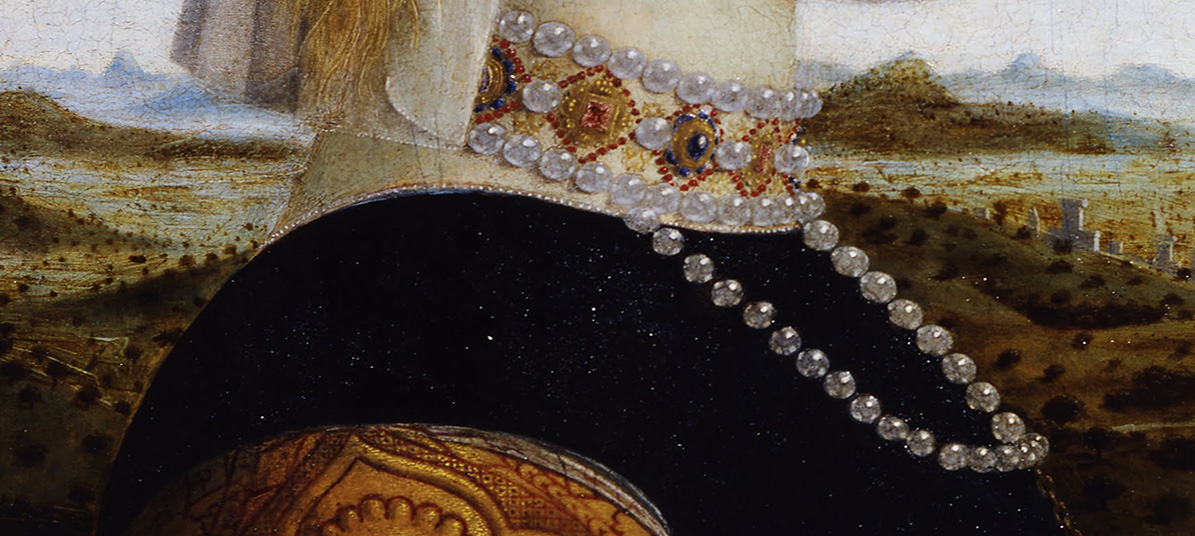| |

  
|
 |

The Balconies of Piero della Francesca | The Hidden Landscapes of Piero Della Francesca in Le Marche and the Montefeltro area
The Montefeltro area is a sub-region scattered between Emilia-Romagna and Tuscany.
Montefeltro is a historical-geographic region in the Marche, which was historically part of Romagna. It gave its name to the Montefeltro family, which ruled in the area during the Middle Ages and the Renaissance.
The Upper valley of the Marecchia River is the heart of the ancient Montefeltro area, a region that hosted famous men such as Dante Alighieri, Saint Francis, Cagliostro and Ezra Pound.`
Since the Middle Ages the Montefeltro has been a much fought-over area.The history of the region has undoubtedly been marked by the clashes between the Malatestas and Montefeltros, by the invasion of the Medicis and the Della Roveres, by the direct control of the Papal States.
Between 1469 and 1486 Piero della Francesca worked repeatedly in the service of Count Federico III da Montefeltro (Duke in 1474).
In 1443 Pope Eugene IV appointed Oddantonio II from Montefeltro, Federico’s father, first Duke of Urbino. Urbino became the capital city of the district and one of the main centres of Italian Renaissance thanks to Federico himself. He attracted the best artists and poets of the time, from Piero della Francesca to Luciano Laurana and Francesco di Giorgio Martini, who planned the majestic Ducal Palace. The decline of the city began when the capital was moved to Pesaro in 1523.[2]
One of the most interesting aspects of the works of Piero della Francesca, whether they are frescoes or panel paintings, is the landscape to which the artist devotes ample space in his works.
Landscapes that inspired Renaissance painters such as Piero della Francesca, Raphael, Leonardo da Vinci are hidden in the hills of Montefeltro. The landscape you can glimpse on the back of the Mona Lisa is the Montefeltro area.[4]
23rd of june 2012, the ‘Balconies of Piero della Franscesca were inaugurated. Different observation points where the landscape that served as background to the renaissance painter can be admired.
Map the balconies of Piero della Francesca
|
|

events
exhibitions
art in tuscany
walking in tuscany
wines
films set in tuscany
the best beaches in tuscany
crete senesi
val d'orcia
market days in tuscany
follow us on instagram

Holiday accomodation
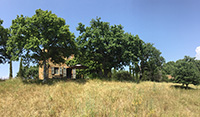
Podere Santa Pia, a formal cloister in the Tuscan Maremma is situated on the outskirts of Castiglioncello Bandini.
Read some reviews
residency |
| |
|
Itinerary in central Italy | In the footsteps of Piero della Francesca |
|
|
| |
|
Those who become enamoured with the practice of the art without having previously applied to the diligent study of the scientific part of it are like mariners who board a ship without a rudder or compass and therefore cannot be certain of arriving at the whished-for port. Practice must always be founded on good theory; to this, Perspective is the guide and entrance, without which nothing can be well done.
Leonardo da Vinci, A Treatise on Painting
|
|
|
| |
|
|
|
|
|
|
|
|
| |
|
The Valmarecchia
|
|
|
|
|
| |
|
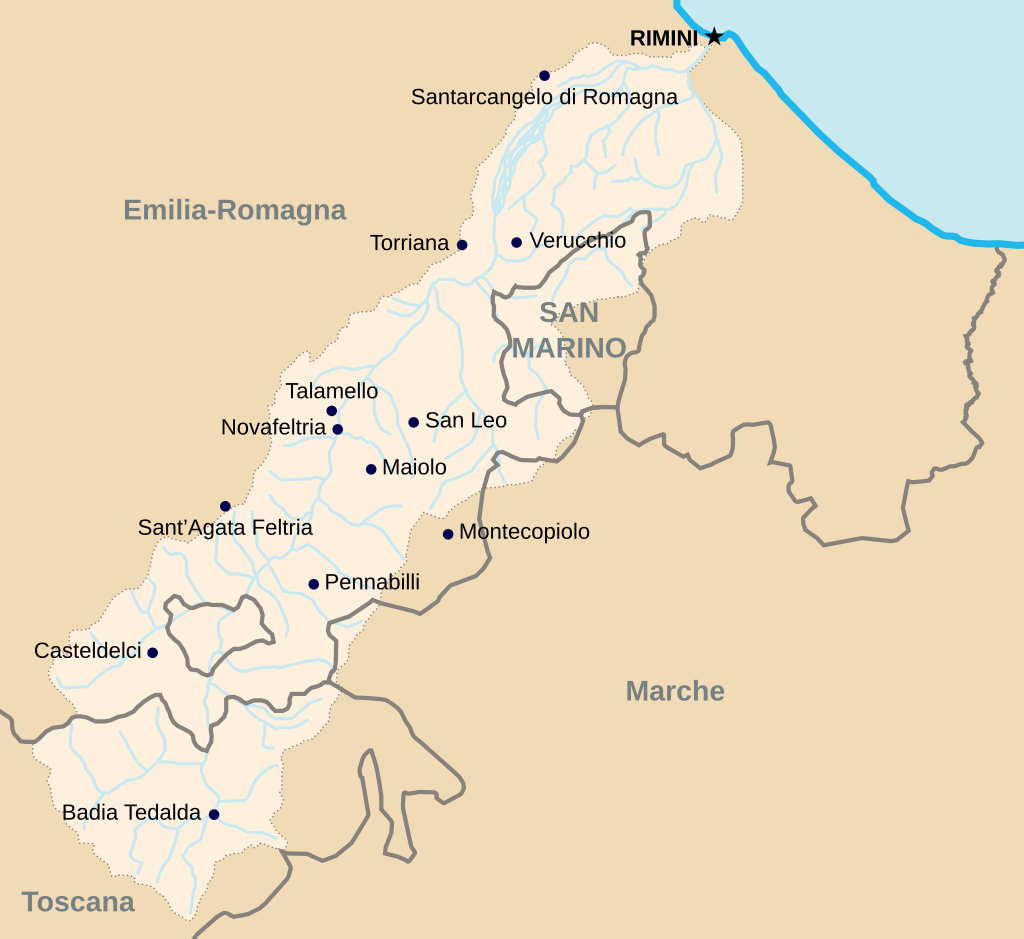 |
|
|
| |
|
Map of Italian valley of river Marecchia [1]
|
|
|
| |
|
Two women, Rosetta Borchia and Olivia Nesci have identified some of the the landscapes behind famous paintings of the Renaissance.
The first landscapes to be discovered, in 2007, were the ones depicted in the paintings of the Diptych of the Duchess and Duke of Urbino by Piero della Francesca (Florence, The Uffizi Gallery). The background landscapes of these first two portraits were hidden in the area of the Metauro River, whereas the third one was located far from there, on the old borders of the Duchy between Tuscany and Emilia-Romagna.
|
|
|
| |
|
Piero della Francesca, Portraits of Federico da Montefeltro and his wife Battista Sforza
Doppio ritratto dei duchi di Urbino (Double Portrait of the Dukes of Urbino), 1465-1472, Uffizi Gallery, Florence
In Varco Biforca-Tausano, there are two Balconies of Piero della Francesca: the one of the portrait of Battista Sforza preserved in the Uffizi Gallery Museum, and the one of Saint Jerome and a Supplicant preserved in the the Gallerie dell’ Accademia in Venice.
|
|
|
| |
|
|
|
|
|
|
|
|
| |
|
The first balcony, set up on Monte Gregorio, overlooks the landscape of the portrait of Battista Sforza, wife of Federico da Montefeltro.
The balconyset up on Monte Gregorio, not far from San Leo, is not the exact observation point chosen by Piero. A different but slightly uphill point of view was chosen, not far Pietracuta, in order to offer onlookers s wider view. [3]
San Leo - Guided Tours schedule to the Balconies on Mount Gregorio
|
|
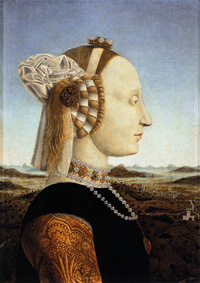 |
|
|
| |
|
|
|
|
|
Ritratto di Battista Sforza | San Leo and the upper area of the Valmarecchia region
|
|
|
| |
|

|
|
|
| |
|
|
|
|
| |
|
Ritratto di Federico da Montefeltro
|
|
|
| |
|
Portrait of Federico da Montefeltro, between Urbania and Sant'Angelo in Vado.
The entire landscape corresponds to a bird’s eye view from a place called Ca’Mocetto, right above the town of Urbania, including an area that goes from the Metauro plain to the crag of Peglio. |
|
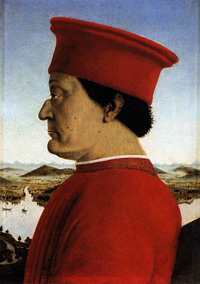 |
|
info
Galleria degli Uffizi
Piazzale degli Uffizi, I-50122 Florence
Web | www.uffizi.firenze.it
Museum Hours
Open Tuesday through Sunday, 8:15am – 6:50pm
Closed: every Monday, January 1, May 1, December 25
Art in Tuscany | Uffizi Gallery
Book your guided tour to Piero della Francesca's balconies in Pieve del Colle, Varco Biforca-Tausano, San Leo, Sant'Agata Feltria, Montecopiolo, Urbania and Acqualagna |
| |
|
|
|
|
|
Ritratto di Federico da Montefeltro | Between Urbania and Sant'Angelo in Vado
|
|
|
| |
|
|
|
|
|
|
|
|
| |
|
 |
|
|
| |
|
The profile of Monte Fronzoso--which you see under Federico's chin--appears exactly the same as it does in the painting. |
|
|
| |
|
St. Jerome and a Donor, Venice
|
|
|
| |
|
A second balcony on the sea (from St. Leo to the coast of Rimini) revealing the landscape at the background of the painting St. Jerome and a Donor.
On the back of St. Jerome and the donor, the Valmarecchia area is painted in great detail. It’s the area of the valley going from Mount Ceti to Montebello, fading into the Adriatic Sea. The vanishing point is, like that of the Baptist of Christ, in the ridge of Mount Gregory. The fortified village in the foreground is a model of fortified citadel, probably Sansepolcro, the birthplace of Piero which he often introduces in his works’ backdrops.
The observation point lies on the ridge of Mount Gregorio and, unlike the three other landscapes of the Diptych; Piero here uses not only an air perspective but also a panoramic one.
On the side of the river closer to us, at the foot of Mount Fotogno, we can distinguish the church with its small cemetery, on the side of the river farer from us, after the Ceti Mountain, we catch a glimpse of the tower of the Church of Uffogliano.[3] |
|
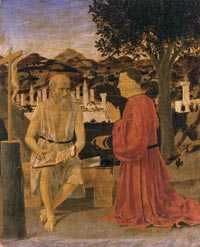 |
|
|
| |
|
|
|
|
|
San Gerolamo e un devoto | From San Leo to Rimini's coastal area.
|
|
|
| |
|
|
|
|
|
|
|
|
| |
|
I Trionfi, the plane land of San Silevestero, between Fermignano and Urbania
|
|
|
| |
|
|
|
|
|
|
|
|
| |
|
 |
|
|
| |
|
I Trionfi | The plane land of San Silevestero, between Fermignano and Urbania |
|
|
| |
|
Another landscape to be discovered is the one on the back of the triumphal chariots of the Dukes of Urbino. Battista and Federico face one another on the natural balcony of Pieve del Colle, with the Metauro valley right below them.
The valley depicted in the Triumphs is a wide plane crossed by the Metauro River and covering the municipalities of Urbania, Fermignano and Acqualagna. |
|
|
| |
|
|
|
|
|
|
|
|
| |
|
|
|
|
|
|
|
|
| |
|
 |
|
|
| |
|
Double portrait of the Dukes of Urbino, landscape continuation |
|
|
| |
|
|
|
|
|
|
|
|
| |
|
|
|
|
| |
|
Other places of interest
|
|
|
| |
|
The background landscape in the Resurrection by Piero della Francesca is located in Montecopiolo (PU), on a stretch of the Via Santa Rita that connects San Marino to Carpegna, traveled several times by the painter in his travels to Rimini, Ferrara, and Bologna.
On the left is represented Monte San Marco; on the right Monte della Croce.
Piero della Francesca | Resurezzione
Discoveer the landscape | www.montefeltroveduterinascimentali.eu
|
|
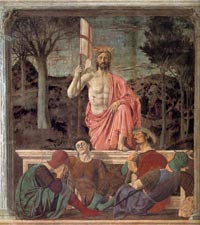 |
|
|
| |
|
|
|
|
|
|
|
|
| |
|
Marecchia, Monte San Marco
|
|
|
| |
|

|
|
|
| |
|
Marecchia, Monte San Marco [5]
|
|
|
| |
|
|
|
|
|
|
|
|
| |
|
|
|
|
|
|
|
|
| |
|
|
|
|
|
|
|
|
| |
|
|
|
|
| |
|
|
|
|
| |
|
|
|
|
|
|
|
|
| |
|
|
|
|
|
|
|
|
| |
|
|
|
|
|
|
| |
|
The balconies are open on Saturdays and Sundays from 5.30 pm to 6.30 pm. Reservation by phone is compulsory (by 1 pm of the day of the visit).
More information and timetable | www.montefeltroveduterinascimentali.eu
Itinerary in San Leo (at Varco Biforca - Tausano)
1. Piero della Francesca - Battista Sforza (from “The Diptych of the Duke and Duchess of Urbino” – Florence, The Uffizi Gallery)
2. Piero della Francesca – Saint Jerome and a Donor (Venice, The Accademia Art Gallery)
Visiting time: about 45 minutes.
Association for Cultural and Social Development “Montefeltro Vedute Rinascimentali” - Tel. +39 366 9508583
Ufficio Turistico I.A.T. Municipality of San Leo - Tel. +39 0541 916306 or +39 0541 916306
www.montefeltroveduterinascimentali.eu
info@montefeltroveduterinascimentali.eu

Rosetta Borchia, Olivia Nesci, Il Paesaggio invisibile, Il lavoro editoriale, 2008
Rosetta Borchia, Olivia Nesci, Il paesaggio invisibile. La scoperta dei veri paesaggi di Piero della Francesca, 2013, Il lavoro editoriale
Visit the site www.lavalmarecchia.it and discover the Montefeltro area
|
|
|
| |
|
Larry Witham, Piero's Light: In Search of Piero della Francesca: A Renaissance Painter and the Revolution in Art, Science, and Religion, Pegasus Books, 2014
|
|
|
| |
|

[1] Photo map of te Marecchia valley by Erinaceus, licensed under the Creative Commons Attribution-Share Alike 3.0 Unported license.
[2] Source: http://www.montefeltroveduterinascimentali.eu/en/montefeltro-region.html
[3] Source: www.montefeltroveduterinascimentali.eu
The results of this first research work are presented in a book, "Il Paesaggio Invisibile" ("The invisible landscape”).
The research project "Piero della Francesca: INVISIBLE LANDSCAPES" was possible thanks to the collaboration between an artist, Rosetta Borchia, paintress and landscape photographer, and Olivia Nesci, professor of geomorphology at the University of Urbino. In a previous publication, “Codice P. - Atlante illustrato del reale paesaggio della Gioconda” ("Code P, The Illustrated Atlas of the Mona Lisa’s Real Backdrop”), published by Electa, Olivia Nesci and Rosetta Borchia presented the results of a four-year research project, which led to identifying the Mona Lisa backdrop right in the Valmarecchia (Montefeltro) area.
[4] The real identity of the woman painted by Leonardo da Vinci has been disclosed. The groundbreaking discovery was the result of the research project by an art historian, Roberto Zapperi, whose book titles "Monna Lisa addio. La vera storia della Gioconda" (Goodbye Mona Lisa: The true story of the Gioconda), published by Le Lettere, and the two landscape hunters, Olivia Nesci and Rosetta Borchia. In their book “Codice P. - Atlante illustrato del reale paesaggio della Gioconda” ("Code P, The Illustrated Atlas of the Mona Lisa’s Real Backdrop”), published by Electa, they present the results of a four-year research project, which led to identifying the Mona Lisa backdrop right in the Valmarecchia (Montefeltro) area. [Source: www.montefeltroveduterinascimentali.eu]
In 2010, Roberto Zapperi published his theory that the person portrayed by Leonardo was not Lisa del Giocondo but Pacifica Brandani. This identification is based on an entry in the diary of Antonio de Beatis, secretary of Cardinal Luigi of Aragon, who describes a visit Leonardo's workshop in Amboise. The artist showed the visitors a portrait of a Florentine lady and told them that it had been commissioned by Giuliano de' Medici, for whom Leonardo had indeed worked from 1513 until his death in 1516. Zapperi identified the sitter as one of Giuliano's mistresses, Pacifica Brandani from Urbino, with whom he had an illegitimate son born in 1511. The picture was supposedly intended as a keepsake to console the child whom Giuliano brought up in his household. [Bettina Wagner, Marcia Reed, Early Printed Books as Material Objects: Proceedings of the Conference Organized by the IFLA Rare Books and Manuscripts Section, Munich, 19-21 August 2009, Walter de Gruyter, 2010, pp. 167-168]
[5] Fonte foto: Cappelletti.roberta, licensed under the Creative Commons Attribution-Share Alike 4.0 International license.
La piana di Boscara dove si sono accampati i tanti eserciti che nel corso dei secoli hanno cercato di conquistare il paese e la fortezza. L'unico lato debole dell'inespugnabile rupe di S.Leo.Sullo sfondo, in primo piano, Maioletto con i ruderi del castello.
|
|
|
| |
|
|
|
|
| |
|
|
|
|
|
|
|
|
| |
|
|
|
|
|
|
|
|
| |
|
|
|
|
|
|
|
|
| |
|
|
|
|
|
|
|
|
| |
|
|
|
|
|
|
|
|
| |
|
|
 |
 |
|
